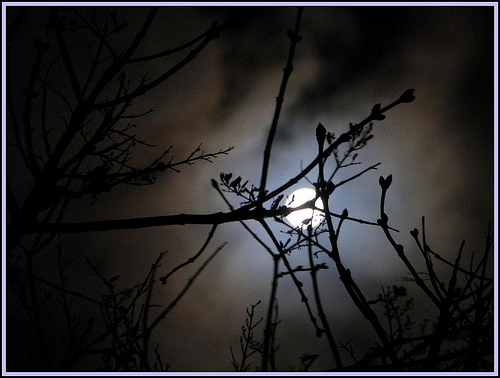
Gardeners learn to observe the cues of nature to properly time their efforts. Simply by paying attention every day to what is going on in the garden you will learn how to identify changes in season by noting the smell of the soil, temperature, precipitation and plant growth rather than relying solely on the calendar. Have you ever noticed that near the middle to end of August the plants seem to already be contracting and going dormant for the season? They may still be showing new growth on the tips but you can see that the shrubs are not as lush and dense even though they have not yet begun to drop their leaves.
For as long as humans have cultivated the land they have used the travels of the sun and the moon for timing and navigation. By using the position of the sun or moon you can determine time and direction without a watch or compass. Observation and practice is all it takes to develop this skill. The sun and moon are constantly changing their positions and path in the sky and at the same time repeat the same cycles over and over again. Just follow the patterns.
In early civilizations, observing the moon was a way to mark time and its cycles would drive agricultural (and other) practices. I am fascinated by the way that the moon affects every living thing on our planet and the fact that this has long been understood by humans. In Native American Cultures each full moon has a name and the names give an indication of what is happening in the natural cycles of the seasons. When the first settlers came to North America they learned from the native people to use the moon for timing and to call each moon by its unique name.
October was considered an important time to hunt in preparation for winter almost everywhere in North America. These are just a few of the names the October full moon goes by:
Hunter’s Moon
Dying Grass Moon
Travel Moon
Blood Moon
Young Animals Moon
These rhythms are common to many cultures. Consider that the Dog month in the Chinese calendar covers most of October. The Dog month was a time of slaughtering the animals that weren’t hardy enough to make it to the next spring. Rather than using up food to keep them going, those animals were used to keep everyone else going.
Gardening is one way that we can keep in touch with nature and its cycles and take comfort in the unchanging repetition of change. Like the Native American people, we need to embrace the patterns of nature because this is a skill we will always need to survive.
I think an awareness of place and constant change enriches our lives in many ways, whether it’s noticing that first fragrance of daphne in winter or seeing the leaves on the trees just beginning to turn in the fall.
The predictability of the seasons gives me something to fall back on when life seems too confusing and unpredictable. No fall will be exactly like another, but I can base my expectations on the pattern.
Understanding where we are in the cycle provides me with a confidence in my own accumulated knowledge and makes me more likely to trust my own judgments rather than the third party advice of people who are not as close to the situation. The ability to do that is just one of the things I get from gardening.

